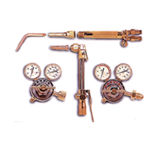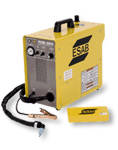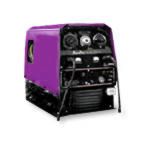Welding Gases
Acetylene | Air | Argon | Carbon Dioxide(CO2) | Helium
Hydrogen | Nitrogen | Oxygen | Propane
Propane
Propane(C3H8),
also known as liquefied petroleum gas (LP-gas), is one of the nation's
most versatile sources of energy and supplies 3 to 4 percent of our
total energy. Propane can be either a liquid or a gas. At normal
atmospheric pressure and temperature, it is a non-toxic, colorless and
odorless gas. Just like natural gas, an identifying odor is added so it
can be readily detected. Under moderate pressure, propane becomes a
liquid that vaporizes into a clean-burning gas when released from
its storage container. Propane is 270 times more compact as a liquid
than a gas, making it economical to store and transport as a liquid.
As opposed to relying on foreign sources, approximately 90 percent of the United States propane supply is produced domestically. Seventy percent of the remaining supply is imported from Canada and Mexico. Natural gas production accounts for 53 percent of our domestic propane supply, while 47 percent is produced from the refining of crude oil.
Propane is called a fossil fuel because it is composed of the remains of plants and animals that inhabited the Earth millions of years ago.
This
remarkable fuel serves approximately 60 million people in the United
States, where approximately 15 billion gallons of propane are consumed
annually. In 1994, propane was used as follows:
- 78.8 million
gallons for utility/gas industry usage
- 507 million
gallons for internal combustion engine use
- 1.5 billion
gallons for other uses including agricultural
- 5.4 billion
gallons for residential/commercial usage
- 9.0 billion
gallons for chemical/industrial usage
Propane is stored as a liquid under moderate pressure and used as a gas. It can be easily and safely stored and transported in liquid form because it is 270 times more compact as a liquid than as a gas. Propane has an extremely low boiling point, allowing it to vaporize to gaseous state at a low temperature. No other fuel has these characteristics.
Propane is clean-burning and efficient because its molecular structure, C3H8, makes it one of the lightest, simplest hydrocarbons. It is colorless, odorless, tasteless and above all, non-toxic.
Tests conducted by the U.S. Environmental Protection Agency have proven that LPG as a motor fuel is significantly cleaner than gasoline. Other studies have shown that, compared to gasoline, propane engines have as much as 45 percent less ozone-forming potential. It is for reasons such as these that Congress in the Clean Air Act of 1990 name LPG as one of the clean-burning alternative fuels designated to take national air quality into the 21st century.
Because propane has been successfully used as a motor fuel for 80 years, a distribution network is firmly in place. There are more than 10,000 public refueling stations nationwide, backed by a growing infrastructure of processing plants, storage facilities and delivery trucks.
History
of Propane
In 1910, a Pittsburgh motor car owner walked into chemist Dr. Walter
Snelling's office, complaining that the gallon of gasoline he had
purchased was half a gallon by the time he got home. He thought the
government should look into why consumers were being cheated because the
gasoline was evaporating at a rapid and expensive rate. Dr. Snelling
took up the challenge and discovered the evaporating gases were propane,
butane and other hydrocarbons.
Using coils from an old hot water heater and other miscellaneous pieces of laboratory equipment he could find, Dr. Snelling built a still that could separate the gasoline into its liquid and gaseous components.
By 1912, propane gas was cooking food in the home. The first car powered by propane ran in 1913, and by 1915 propane was being used in torches to cut through metal. Propane was marketed for flame cutting and cooking applications by 1920.
In 1927, the total sales of propane in the U. S. were more than one million gallons, and after World War II the propane gas annual sales increased to more than 15 billion gallons.
By the 1930s, the Compressed Gas Association (CGA) established and proposed a set of recommendations to the National Fire Protection Association (NFPA). In 1932, the first pamphlet of standards (No. 58) was adopted for publication.
When Dr. Snelling sold his propane patent to Frank Phillips, the founder of Phillips Petroleum Company, his price was $50,000. Today, propane gas is an $8 billion industry in the United States alone and it is still growing.
| DOT Information | ||
| DOT Name: | Propane | |
| DOT Hazard Class: | Flammable Gas | |
| DOT Label: | Flammable Gas | |
| DOT ID No.: | UN 1075 | |
| CAS No.: | 74-98-6 | |
| Valve Outlet: | CGA 510, CGA 300, CGA **** | |
| Physical State in Cylinder: Liquid | ||
| Toxicity: | Non-toxic | |
| Fire Potential: | Flammable | |
| Major Hazards: | Suffocation, Flammable | |
| Physical Properties of Propane | ||
| Formula: | C3H8 | |
| Molecular Weight: | 44.10 lb/mol | |
| Specific Volume at 70°F and 1 atm: | 8.62 ft3/lb | |
| Specific Heat: | 17.71 BTU/lbmol-deg F@ 70 deg. F. | |
| Specific Gravity: | 1.576 | |
| Gas Density: | .1160 lb/ft3 @ 70 deg. F. 14.7 PSIA | |
| Psat @ 70 deg F: | 124.9 PSIA | |
| Liquid Density @ 70 deg F: | 31.12 lb/ft3 | |
| Boiling Point | ||
| Temperature: | -43.76 deg. F | |
| Liquid Density: | 36.28 lb./ft3 | |
| Latent Heat: | 183.0 BTU/lb. | |
| Critical Point | ||
| Temperature: | 206.3 deg. F | |
| Pressure: | 618.7 PSIA | |
Combustion Data |
||
| Ft3 of Air Required to Burn 1 Ft3 of Gas: | 23.86 | |
| Flash Point: | -156 deg F | |
| Ignition Temperature in Air: | 920-1020 deg. F. | |
| Maximum Flame Temperature in Air: | 3595 deg F | |
| Limits of Inflammability, Percentage of Gas in Air Mixture | ||
| At Lower Limit: | 2.4% | |
| At Upper Limit: | 9.6% | |
| Octane #: | Over 100 | |
Propane Rental Cylinders Available
PART NUMBER |
CYLINDER SIZE |
APPROX. |
PRESSURE |
DIMENSIONS |
CAPACITY |
CAPACITY |
PRO033 |
33 lbs. |
**** lbs. |
||||
PRO100 |
100 lbs. |
**** lbs. |




